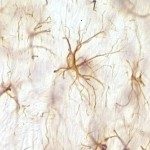Link to Pubmed [PMID] – 8719661
Res. Immunol. 1995 Jul-Aug;146(6):373-82
A high-affinity anti-tenanus toxoid (TT) human monoclonal antibody showing neutralizing activity was isolated from a fusion between mouse myeloma and human splenic cells. Fab fragments from this antibody were obtained using a recombinant phage surface-display expression system. The parental antibody and the corresponding Fab had identical immunological activities, including specificity and affinity. These results confirm the feasibility of developing Escherichia coli expression of monoclonal human Fab from hybridoma cells.


